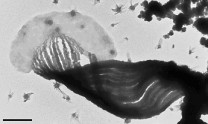Mariprofundus ferrooxydans: Difference between revisions
| Line 35: | Line 35: | ||
Habitat; symbiosis; biogeochemical significance; contributions to environment.<br> | Habitat; symbiosis; biogeochemical significance; contributions to environment.<br> | ||
If relevant, how does this organism cause disease? Human, animal, plant hosts? Virulence factors, as well as patient symptoms.<br><br> | If relevant, how does this organism cause disease? Human, animal, plant hosts? Virulence factors, as well as patient symptoms.<br><br> | ||
Mariprofundus ferrooxydans was first discovered at the hydrothermal vents at Loihi Seamount, Hawaii. Here, the temperature is low, iron is abundant, and microbial mats of iron oxides surround the . These mats are formed and maintained primarily by iron-oxidizing bacteria, such as M. ferrooxydans. [3] | |||
==References== | ==References== | ||
Revision as of 07:02, 23 April 2013
Classification
Domain: Bacteria; Phylum: Proteobacteria; Class: Zetaproteobacteria; Order: Mariprofundales; Family: Mariprofundaceae; Genus: Mariprofundus [Others may be used. Use NCBI link to find]
Species
|
NCBI: Taxonomy |
Mariprofundus ferrooxydans
Description and Significance
Describe the appearance, habitat, etc. of the organism, and why you think it is important. "Mariprofundus ferrooxydans" is a marine iron-oxidizing bacteria and is the sole member of the Zetaproteobacteria class. The cells are motile, bean-shaped, and exude stalks for the excretion iron oxides. [1] It is a gram negative microaerophile
Genome Structure
Describe the size and content of the genome. How many chromosomes? Circular or linear? Other interesting features? What is known about its sequence?
Cell Structure, Metabolism and Life Cycle
Interesting features of cell structure; how it gains energy; what important molecules it produces.
"Mariprofundus ferrooxydans" forms stalks that are used for the excretion and extracellular storage of oxidized iron. Iron oxyhydroxides, also known as rust, along with carboxyl-rich polysaccharides are the main components of the stalks and it is thought that these components are bound together upon excretion from the cell [1].
Energy is gained from oxidizing iron, in which reduced iron is the electron donor and oxygen is the electron receptor. Although it is an obligate iron oxidizer, cells have been cultivated on the surface of electrodes in the absence of Fe(II), during which the cells divided successfully but did not excrete stalks [4].
Ecology and Pathogenesis
Habitat; symbiosis; biogeochemical significance; contributions to environment.
If relevant, how does this organism cause disease? Human, animal, plant hosts? Virulence factors, as well as patient symptoms.
Mariprofundus ferrooxydans was first discovered at the hydrothermal vents at Loihi Seamount, Hawaii. Here, the temperature is low, iron is abundant, and microbial mats of iron oxides surround the . These mats are formed and maintained primarily by iron-oxidizing bacteria, such as M. ferrooxydans. [3]
References
[1] [Chan, C. S., S. C. Fakra, D. Emerson, E.J. Fleming, and K.J. Edwards. "Lithotrophic iron-oxidizing bacteria produce organic stalks to control iron mineral growth: implications for biosignature formation". ISME Journal (2011) 5, p. 717-727.]
[2]
[3]
[4] Summers, Z.M., J.A. Gralnick, D.R. Bond. 2013. "Cultivation of an Obligate Fe(II)-Oxidizing Lithoautotrophic Bacterium Using Electrodes". mBio 4(1):e00420-12. doi: 10.1128/mBio.00420-12.
Author
Page authored by Angela DeTomaso, student of Prof. Jay Lennon at Michigan State University.
<-- Do not remove this line-->

